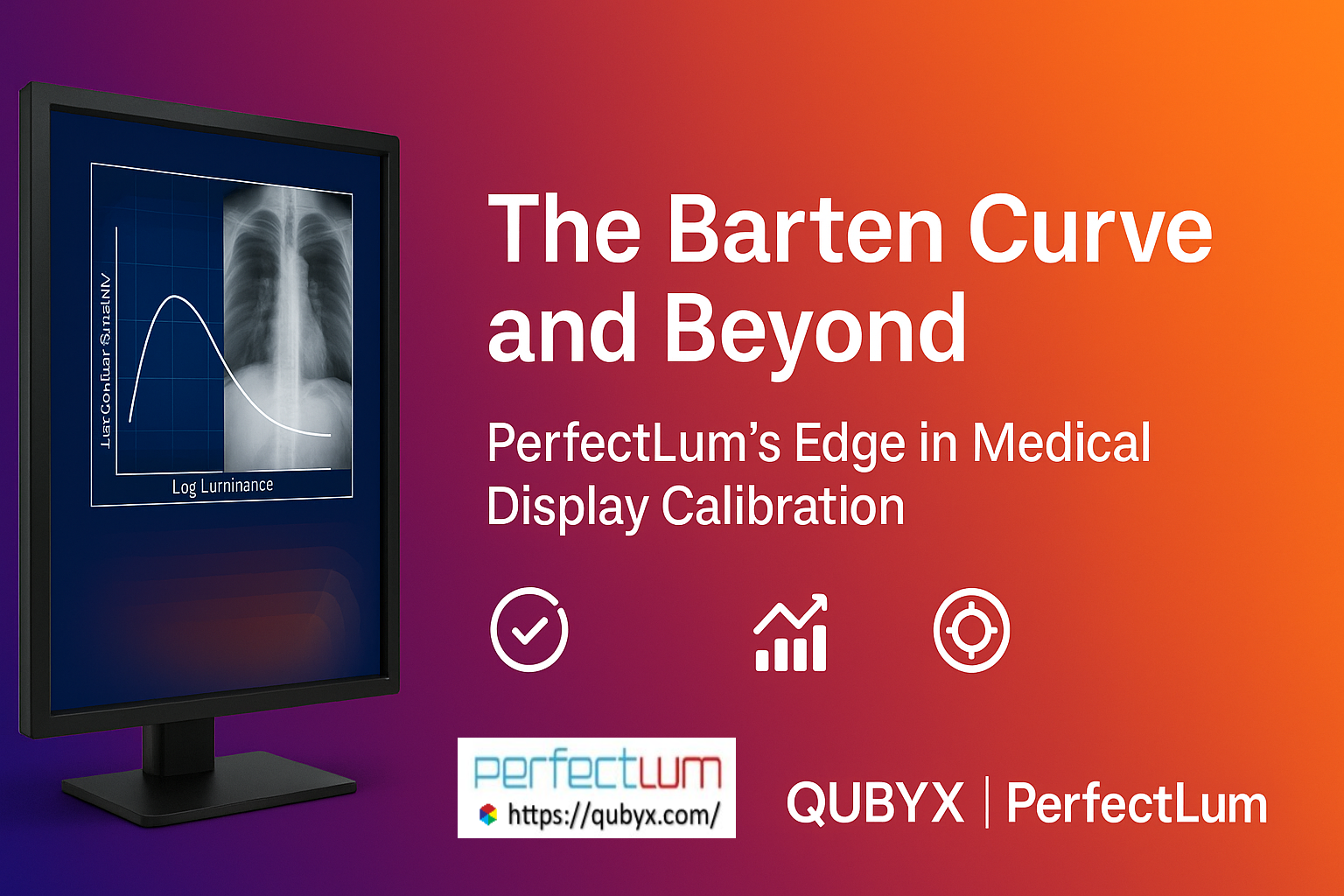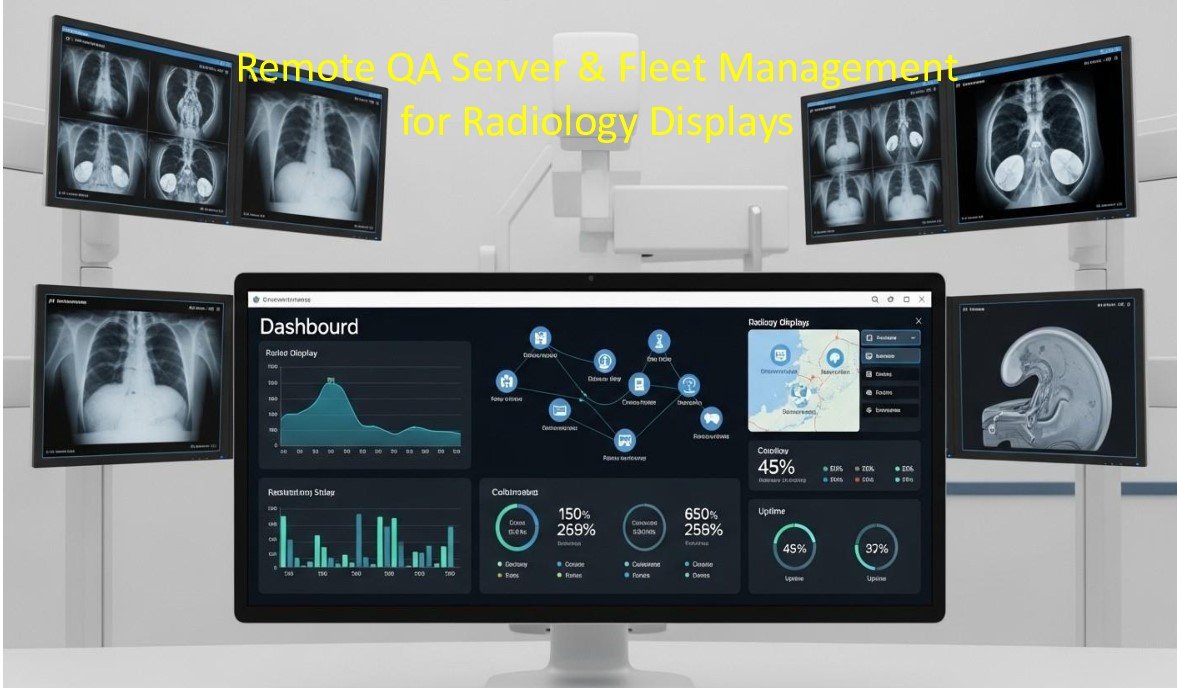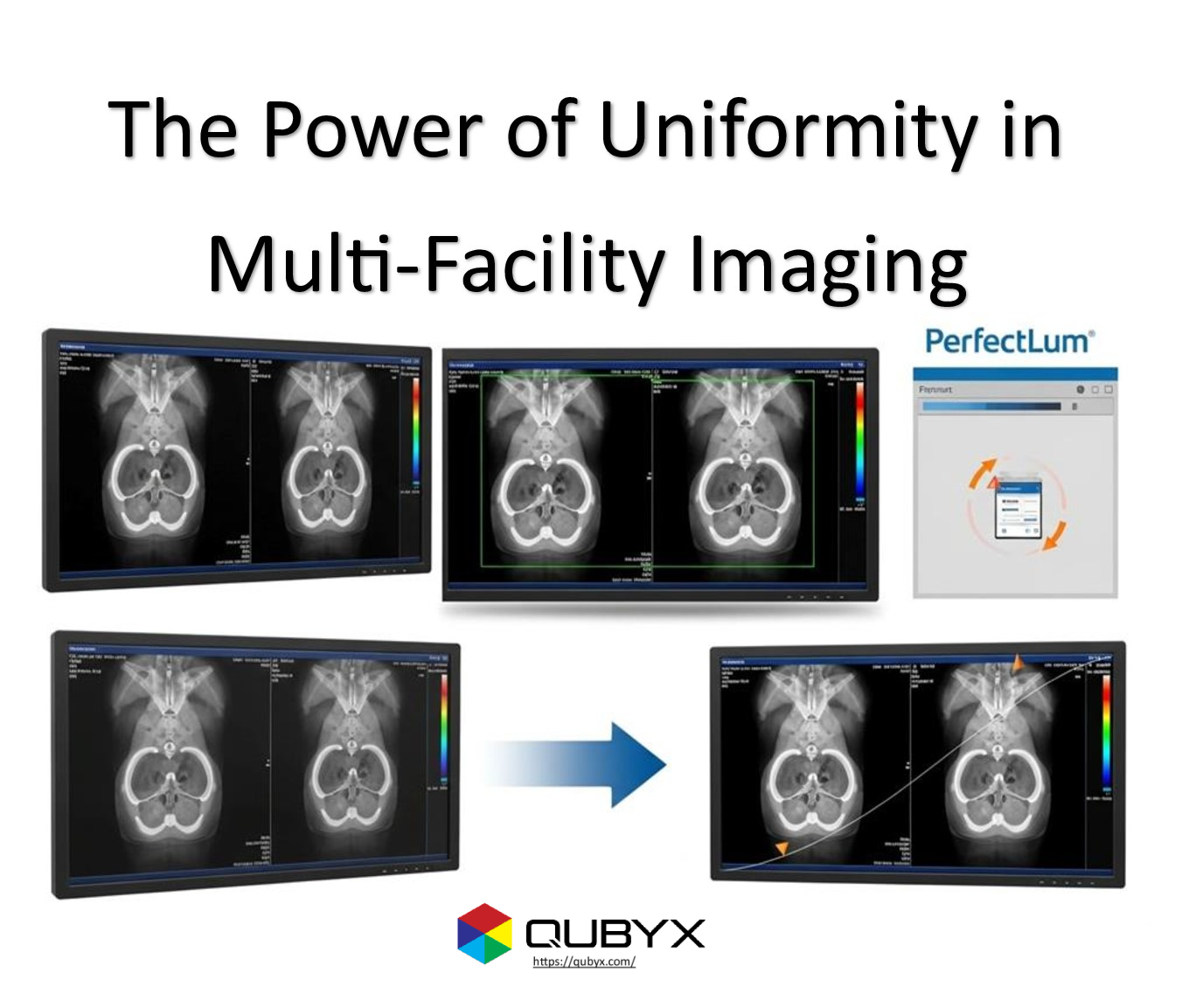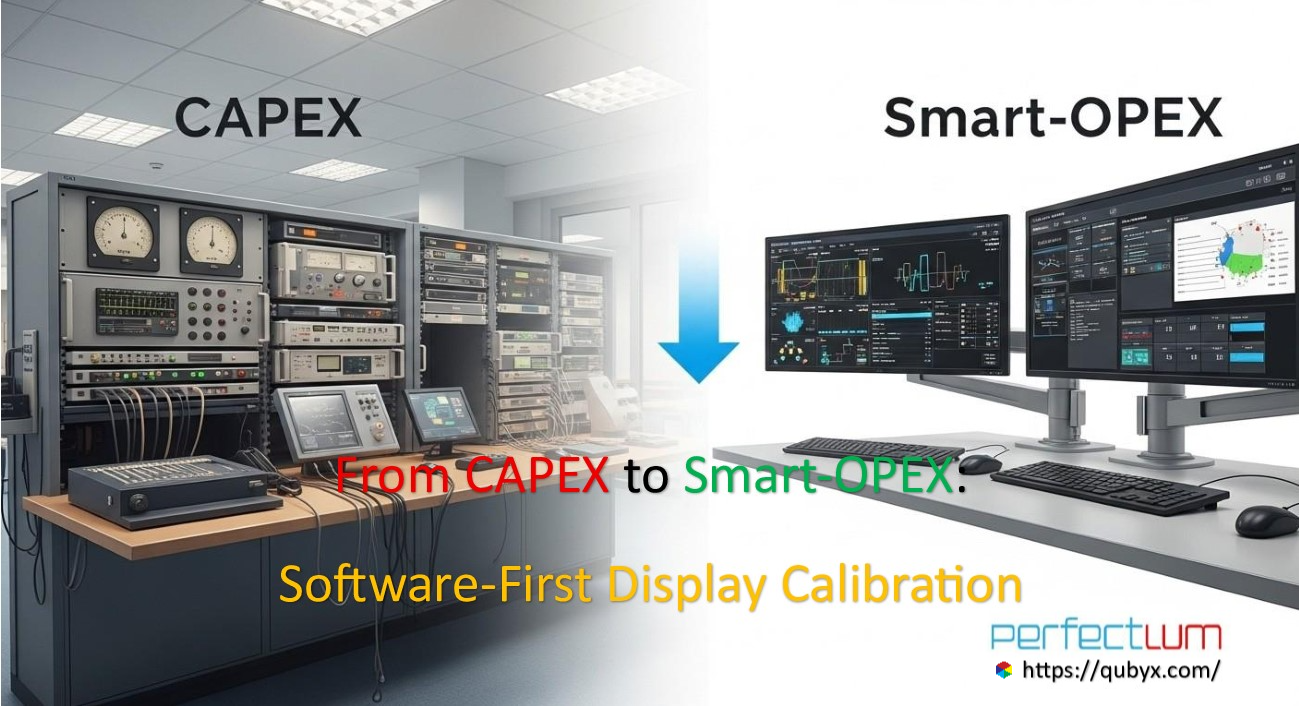News
- Home
- Barten Curve & PerfectLum | Medical Display Calibration

Barten Curve & PerfectLum | Medical Display Calibration
- September 10, 2025
- Shamsul
The Barten Curve & Beyond | PerfectLum Medical Display Calibration
In diagnostic imaging, a lesion that’s barely there is still there. Whether it’s a microcalcification at the edge of visibility or a low-contrast lesion blending into background parenchyma, the difference between “seen” and “missed” is often measured in fractions of a just noticeable difference. That’s why serious radiology programs don’t calibrate by eye—they calibrate by vision science. At the heart of that science sits the Barten contrast-sensitivity model, the Barten Curve behind DICOM Part 14’s Grayscale Standard Display Function (GSDF) and the broader concept of JND (Just Noticeable Difference) uniformity.
This article unpacks the Barten curve in clear terms, then goes beyond it—showing how PerfectLum translates vision science into daily operational excellence: precise calibration, automated QA, ambient-aware viewing, color fidelity for hybrid workflows, and enterprise-grade fleet control.
A plain-English tour of the Barten curve
Human vision is not linear. We are exquisitely sensitive to certain contrasts at specific luminance ranges and spatial frequencies, and less sensitive in others. The Barten Curve model formalizes this behavior as a contrast sensitivity function (CSF) that predicts the minimum detectable contrast under defined conditions (luminance, noise, viewing distance/angle, integration time, etc.).
Here’s the practical takeaway:
- Equal pixel steps are not equal to the eye. A ten-level increase in digital driving level (DDL) doesn’t translate to an equal perceptual step across the tone scale.
- Perceptual uniformity requires remapping. To make each gray step look equally different, you must map the display’s luminance output so that constant increments correspond to constant JND increments.
- GSDF turns Barten Curve into a target. DICOM Part 14 GSDF encodes a luminance curve where adjacent grayscale levels are separated by equal JNDs. That ensures faint details are not swallowed in deep shadows or washed out in highlights.
When a monitor drifts from GSDF, the midtones may crowd together, shadows may lose subtlety, and highlights may expand—so the same dataset can appear “different” day to day or station to station.
PerfectLum’s calibration engine: from Barten Curve to bedrock
PerfectLum operationalizes Barten Curve GSDF so that clinical images land on the retina as intended.
- Measured response, not guesswork
PerfectLum measures the display’s native luminance response across the grayscale. From these data, it computes corrections that align the monitor with GSDF, equalizing JND steps across the tone curve. - Shape and scale: Lmax/Lmin control
Calibrating the shape of the curve is only half the job. Clinical relevance hinges on maximum luminance (Lmax) and minimum luminance (Lmin)—they determine contrast headroom and shadow detail. PerfectLum helps you hit policy targets for both, preserving visibility in critical ranges. - Hardware LUTs where possible
On medical-grade displays with internal LUTs, PerfectLum writes high-precision corrections directly to the panel’s hardware. On other monitors, well-managed GPU LUTs and dithering maintain fidelity and smooth gradations without banding. - Uniformity and multi-monitor matching
Visual decisions rarely happen on a single screen. PerfectLum’s approach supports inter-display matching, reducing cognitive friction when readers compare prior studies or review cases in different rooms.
Beyond brightness and gamma: what really affects clinical visibility
The Barten curve explains why perceptual uniformity matters. PerfectLum ensures it holds in the real world by controlling variables that erode diagnostic visibility:
- Ambient illuminance and reflections
Too much room light compresses apparent contrast and shifts perceived black level. PerfectLum supports ambient light assessment and guidance so viewing conditions remain within policy—helping GSDF compliance translate into perceived compliance. - Temporal stability and warm-up
Displays behave differently at cold start. PerfectLum encourages warm-up discipline and monitors stability so morning reads don’t look subtly different from mid-day reads. - Bit depth and dither quality
Poor LUT precision or low effective bit depth can introduce contouring. PerfectLum’s calibration path is designed to maintain smooth gradients across the scale. - Color in a grayscale world
Modern workflows increasingly overlay color: PET/CT fusions, perfusion maps, annotations, dermatology images, and surgical planning. PerfectLum supports color characterization with measurable ΔE targets, aligning white points and gamut so color cues remain reliable across stations.
QA is where compliance lives day to day
Even a perfect calibration decays with use. Backlights age, panels drift, Barten Curve, OS updates nudge profiles, and end-users tweak brightness. Constancy testing is the antidote.
PerfectLum makes QA habitual rather than heroic:
- Acceptance testing to lock in a baseline at installation with documented pass/fail criteria.
- Automated constancy schedules—daily quick checks for primary diagnostic stations, weekly/monthly for others—verifying GSDF adherence, luminance, black level, and (where relevant) color drift.
- Standards-based patterns and tolerances that align with common frameworks (e.g., AAPM TG18, DIN 6868 series) so physicists and QC teams work within familiar procedures.
- Actionable thresholds and guidance so out-of-tolerance results lead to fixes, not just findings.
- Trend analytics that surface slow degradation before it becomes a clinical problem.
The outcome is not just a certificate pinned to a wall, but a living record of display health.
Barten Curve Compliance you can prove: audit-ready documentation
In accreditation cycles, quality reviews, and medico-legal contexts, traceability matters. PerfectLum produces tamper-evident, time-stamped reports that capture:
- Device identity (model/serial), location, operator, and policy targets
- Calibration method (hardware vs GPU LUT), ambient condition notes
- Acceptance and periodic results with pass/fail status and tolerances
- Trend graphs for Lmax, Lmin, Barten Curve, GSDF deviation, and ΔE (where applicable)
- Corrective actions and re-test outcomes
When an inspector asks, “How do you know these displays meet policy?” you don’t provide opinions—you provide records.
Enterprise-scale control without the chaos
A single reading room can be tuned by hand. A multi-site network cannot. PerfectLum addresses the operational realities of modern imaging services:
- Centralized policy templates by department, modality, or room type (e.g., stricter specs for mammography).
- Remote scheduling and execution of calibrations and constancy tests during off-hours to avoid workflow disruption.
- Dashboards and alerts that surface outliers at a glance, rather than burying them in spreadsheets.
- Role-based access for medical physicists, PACS admins, and biomed engineers so everyone has the controls—and limits—they need.
- Cross-platform deployment across Windows (including Windows 11) and macOS fleets for unified governance.
The result is fewer desk-side visits, faster remediation, and a predictable cost of quality.
Where the extra edge shows up clinically
Mammography
Subtle microcalcifications and faint spiculations live at the edge of perception. Barten Curve GSDF adherence, high and stable Lmax, tight black levels, and controlled ambient light pay outsized dividends here. PerfectLum enforces the full stack—curve, scale, and environment.
CT and MR
Low-contrast detectability depends on midtone uniformity and absence of banding. With proper calibration and QA, window/level adjustments behave predictably, reducing reader fatigue and re-reads.
Hybrid and nuclear medicine
Color overlays must remain consistent across stations. PerfectLum’s color pipeline and ∆E tracking ensure that the “same” SUV or perfusion map looks the same to every reader, avoiding miscommunication.
Pathology, dentistry, dermatology, and surgery planning
As imaging becomes more visual-informatics-driven, calibrated color and consistent white points reduce surprises when cases move between clinics or telemedicine endpoints.
Barten Curve – A pragmatic rollout plan
- Inventory and baseline
Catalogue every display, its role, age, hours, environment, and current performance. Run initial measurements to quantify spread and prioritize work. - Define policies with stakeholders
Set targets for GSDF tolerance, Lmax/Lmin, ambient range, white point, ∆E thresholds, and QA intervals. Distinguish diagnostic from secondary review specs. - Calibrate high-impact stations first
Start with reading rooms and mammography. Use hardware LUTs where available; standardize warm-up and room-light practice. - Automate QA
Configure constancy schedules and alerts. Daily quick checks for primary diagnostic stations; weekly/monthly for others. Plan quarterly or semiannual deep checks. - Centralize reporting
Archive acceptance and periodic reports in a controlled repository with access rules and retention policy. Review trends monthly. - Expand to the edge
Extend to technologist and consultation stations, then to surgical planning and clinics—anywhere images inform care.
Read More:
How PerfectLum Ensures Diagnostic-Grade Accuracy?
Pitfalls to avoid and Barten Curve (and how PerfectLum helps)
- Treating gamma as GSDF
A simple “gamma 2.2” curve is not perceptually uniform. PerfectLum targets GSDF, not generic gamma, to align with JND spacing. - Ignoring ambient light
Calibrated in the dark, read in a bright room? Apparent contrast collapses. PerfectLum’s ambient guidance keeps the environment inside policy so calibration holds up in practice. - One-and-done calibration
Drift is inevitable. Automated constancy checks and alerts keep you compliant between calibrations. - Assuming commodity panels are “close enough”
Secondary review and acquisition stations influence clinical decisions, too. PerfectLum reduces variability everywhere, and documents the difference. - Skipping documentation
If it isn’t logged, it didn’t happen—at least to an auditor. PerfectLum’s audit-ready reports close that gap.
FAQs
Is the Barten Curve model only about grayscale?
It underpins perceptual handling of contrast for grayscale tone mapping. PerfectLum implements GSDF for grayscale and adds a color management layer (white point, gamut, ∆E metrics) for workflows where color matters.
Can we achieve ∆E < 1 on every monitor?
On supported, stable hardware with controlled ambient light—often yes. On commodity displays the numbers may be higher, but still tight enough for consistent overlays. PerfectLum tracks the actuals so you know, not guess.
How often should we recalibrate?
Calibrate at acceptance, then recalibrate when constancy tests indicate drift beyond tolerance. Mission-critical stations may warrant more frequent checks than secondary displays.
Will readers notice a difference after calibration?
Usually—images become more predictable, especially in shadows and midtones. After a brief adjustment, most readers prefer the stability.
The bottom line
The Barten curve isn’t trivia; it’s the backbone of diagnostic visibility. It explains why equal pixel steps don’t look equal and why GSDF is the right target for clinical displays. PerfectLum turns that insight into a system—precise GSDF calibration, Lmax/Lmin control, ambient-aware viewing, color fidelity, automated constancy testing, trend analysis, enterprise management, and audit-grade documentation.
That’s the difference between hoping a faint signal will be seen and engineering a reading environment where, day after day, workstation after workstation, subtle signals stay visible. With PerfectLum, the science is built in, the process is automated, and the proof is on file—so your clinicians can focus on patients, not pixels.
At QUBYX, we don’t just enhance images—we redefine what image quality means for the industries that depend on it.
Barten Curve, PerfectLum calibration, medical display QA, DICOM Part 14 GSDF, just noticeable difference, JND uniformity, radiology display calibration, diagnostic imaging accuracy, medical monitor calibration software, ambient light medical imaging, automated QA medical displays, enterprise display compliance
Related Posts
- October 27, 2025
- News
Remote QA & Fleet Management for Home and Hospital Displays
- October 26, 2025
- News
The Power of Uniformity | How PerfectLum Solved a Multi-Facility
- October 25, 2025
- News
From CAPEX to Smart-OPEX: Shifting Hospital Calibration Spending with Software




